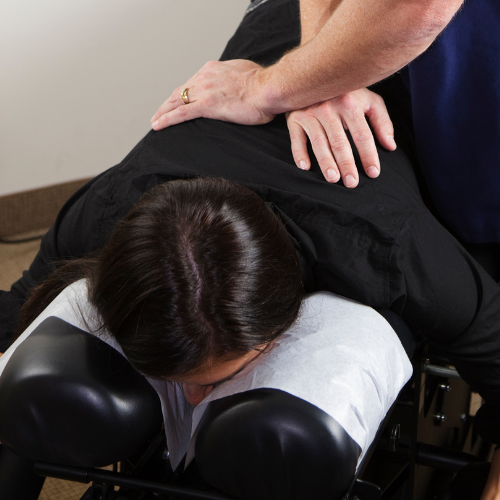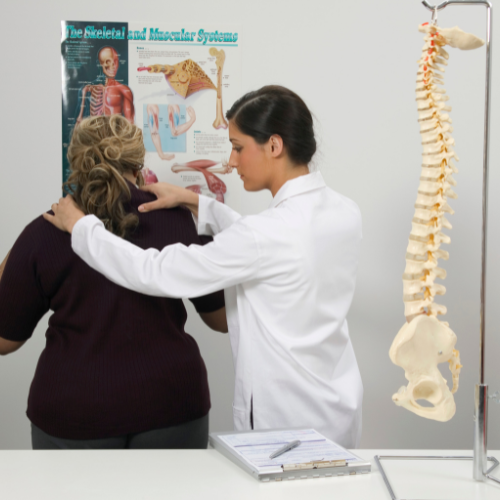
We’re Here To help
Spaulding Chiropractic Clinic
Serving Customers in Fairbanks & Surrounding Areas



 Hailey Gundersen2024-11-15I have been seeing Dr. Berg since the middle of my second trimester and it has helped subside all lower back pain throughout my pregnancy. I’m now at 35 weeks and feeling great! Could not recommend his care more.
Hailey Gundersen2024-11-15I have been seeing Dr. Berg since the middle of my second trimester and it has helped subside all lower back pain throughout my pregnancy. I’m now at 35 weeks and feeling great! Could not recommend his care more. Angela Holland2024-07-12Great chiropractors. Amazing massage therapists.
Angela Holland2024-07-12Great chiropractors. Amazing massage therapists. Caitlin Schnaidt2024-06-07I can't speak highly enough about Dr. Berg and the entire teqm at Spaulding. I am pregnant and have been suffering from bad sciatica which made doing most basic things throughout the day extremely challenging. After starting to see Dr. Berg I am finally able to get through the day without being in a constant state of pain. He also sees my special needs toddler and we have seen great improvements in his physical movements and comfort level since beginning to see Dr. Berg. He is knowledgeable, professional, friendly, warm, and overall an amazing chiropractor. Everyone in the office is friendly, warm, and welcoming. I was very hesitant about starting to see a chiropractor while pregnant and have been nothing but pleasantly surprised and satisfied with the results of both my own, and my son's, experiences. If you're looking for a chiropractors office I highly recommend Dr. Berg and Spaulding chiropractic.
Caitlin Schnaidt2024-06-07I can't speak highly enough about Dr. Berg and the entire teqm at Spaulding. I am pregnant and have been suffering from bad sciatica which made doing most basic things throughout the day extremely challenging. After starting to see Dr. Berg I am finally able to get through the day without being in a constant state of pain. He also sees my special needs toddler and we have seen great improvements in his physical movements and comfort level since beginning to see Dr. Berg. He is knowledgeable, professional, friendly, warm, and overall an amazing chiropractor. Everyone in the office is friendly, warm, and welcoming. I was very hesitant about starting to see a chiropractor while pregnant and have been nothing but pleasantly surprised and satisfied with the results of both my own, and my son's, experiences. If you're looking for a chiropractors office I highly recommend Dr. Berg and Spaulding chiropractic. Payton Baker2024-05-30Dr. Berg is hands down the best! Helped me through ALL my pregnancy pains and worked me in his schedule when I needed an adjustment ASAP! 100% recommend for anyone!
Payton Baker2024-05-30Dr. Berg is hands down the best! Helped me through ALL my pregnancy pains and worked me in his schedule when I needed an adjustment ASAP! 100% recommend for anyone! Josh Handeland2024-05-28Love theses people they are the best in town
Josh Handeland2024-05-28Love theses people they are the best in town Maggie Matheson2024-05-24Everyone is so sweet and helpful. I’ve had emergent pain and they got me right in and they are so helpful.
Maggie Matheson2024-05-24Everyone is so sweet and helpful. I’ve had emergent pain and they got me right in and they are so helpful. Tracey Ferguson2024-05-24Great staff
Tracey Ferguson2024-05-24Great staff Meghan Hoffman2024-05-20I've been seeing Dr. Wyatt Berg throughout my entire eight months of pregnancy so far, and I can't recommend him enough! He is incredibly understanding and knowledgeable about the specific needs of pregnant women. He always takes the time to listen to my concerns and adjusts my treatments accordingly. His adjustments have helped to alleviate my lower back pain and improve my sleep. Most recently, my baby went from being in the breech position to head down after a couple of adjustments. Thanks to Dr. Berg's care, I’ve felt much more comfortable and mobile throughout my pregnancy. I highly recommend him to any pregnant women or any individual who is looking for a natural and effective way to manage aches and pains. Alisha Greenberg (Massage Therapist) and Teresa Grotkopp (Acupuncturist) I would also highly recommend. The cherry on top is that the office staff at Spaulding Chiropractic is always friendly and helpful.
Meghan Hoffman2024-05-20I've been seeing Dr. Wyatt Berg throughout my entire eight months of pregnancy so far, and I can't recommend him enough! He is incredibly understanding and knowledgeable about the specific needs of pregnant women. He always takes the time to listen to my concerns and adjusts my treatments accordingly. His adjustments have helped to alleviate my lower back pain and improve my sleep. Most recently, my baby went from being in the breech position to head down after a couple of adjustments. Thanks to Dr. Berg's care, I’ve felt much more comfortable and mobile throughout my pregnancy. I highly recommend him to any pregnant women or any individual who is looking for a natural and effective way to manage aches and pains. Alisha Greenberg (Massage Therapist) and Teresa Grotkopp (Acupuncturist) I would also highly recommend. The cherry on top is that the office staff at Spaulding Chiropractic is always friendly and helpful. Nigel Morton2024-05-20Dr. Berg truly cares about his craft and his patients. His care shows in the form results from appointment to appointment.
Nigel Morton2024-05-20Dr. Berg truly cares about his craft and his patients. His care shows in the form results from appointment to appointment. Cody Whiteley2024-05-09I took my 6 week old baby to see DR. Berg for hard to pass gas, excessive fussiness and instantly he was able to ease my baby. Over just a couple visits we noticed a huge difference and baby was much happier. We took him back again at 4 months because he was constipated - google told us it was normal to have inconsistent bowel movements around his age but it made him extremely fussy and uncomfortable. Within a couple hours after seeing DR Berg our baby began making regular bowel movements again and his mood improved drastically. My wife also saw Dr Berg after giving birth and having multiple complaints of pain and unusual sensations. He helped realign her pelvis, hips and relieve upper back/neck pain associated with breastfeeding/ holding baby. Dr Berg is incredibly knowledgeable, holistic and personable. He has a baby of his own so he is very gentle and intuitive. We cant recommend his expertise enough, he truly takes the time to listen, notice, and fix the problem or recommend resources or other specialists. To say the least, Chiropractic care with Dr Berg has been a game changer for both baby and momma. Fairbanks is truly lucky to have this high quality care.
Cody Whiteley2024-05-09I took my 6 week old baby to see DR. Berg for hard to pass gas, excessive fussiness and instantly he was able to ease my baby. Over just a couple visits we noticed a huge difference and baby was much happier. We took him back again at 4 months because he was constipated - google told us it was normal to have inconsistent bowel movements around his age but it made him extremely fussy and uncomfortable. Within a couple hours after seeing DR Berg our baby began making regular bowel movements again and his mood improved drastically. My wife also saw Dr Berg after giving birth and having multiple complaints of pain and unusual sensations. He helped realign her pelvis, hips and relieve upper back/neck pain associated with breastfeeding/ holding baby. Dr Berg is incredibly knowledgeable, holistic and personable. He has a baby of his own so he is very gentle and intuitive. We cant recommend his expertise enough, he truly takes the time to listen, notice, and fix the problem or recommend resources or other specialists. To say the least, Chiropractic care with Dr Berg has been a game changer for both baby and momma. Fairbanks is truly lucky to have this high quality care.
About Us
We have a passion for getting people better and you now have a chance to benefit from that. Everyday we deal with people who are in pain and have been left out in the cold by the medical mainstream. If you are tired of telling your doc that you have pain and then being given a painkiller, we are for you. Somewhere inside you know that your pain is not caused by a lack of painkiller or anti-inflammatory in your system. Chiropractic gets to the root cause of your pain. Poor joint alignment and motion is the cause of most back and neck pain and no amount of painkiller or anti-inflammatory will ever correct this issue. Only your Chiropractor can correct the alignment and motion issues. At Spaulding Chiropractic Clinic, we get to the cause of your problem. Do not chase symptoms! Get to the cause with Chiropractic care.
 Hailey Gundersen2024-11-15I have been seeing Dr. Berg since the middle of my second trimester and it has helped subside all lower back pain throughout my pregnancy. I’m now at 35 weeks and feeling great! Could not recommend his care more.
Hailey Gundersen2024-11-15I have been seeing Dr. Berg since the middle of my second trimester and it has helped subside all lower back pain throughout my pregnancy. I’m now at 35 weeks and feeling great! Could not recommend his care more. Angela Holland2024-07-12Great chiropractors. Amazing massage therapists.
Angela Holland2024-07-12Great chiropractors. Amazing massage therapists. Caitlin Schnaidt2024-06-07I can't speak highly enough about Dr. Berg and the entire teqm at Spaulding. I am pregnant and have been suffering from bad sciatica which made doing most basic things throughout the day extremely challenging. After starting to see Dr. Berg I am finally able to get through the day without being in a constant state of pain. He also sees my special needs toddler and we have seen great improvements in his physical movements and comfort level since beginning to see Dr. Berg. He is knowledgeable, professional, friendly, warm, and overall an amazing chiropractor. Everyone in the office is friendly, warm, and welcoming. I was very hesitant about starting to see a chiropractor while pregnant and have been nothing but pleasantly surprised and satisfied with the results of both my own, and my son's, experiences. If you're looking for a chiropractors office I highly recommend Dr. Berg and Spaulding chiropractic.
Caitlin Schnaidt2024-06-07I can't speak highly enough about Dr. Berg and the entire teqm at Spaulding. I am pregnant and have been suffering from bad sciatica which made doing most basic things throughout the day extremely challenging. After starting to see Dr. Berg I am finally able to get through the day without being in a constant state of pain. He also sees my special needs toddler and we have seen great improvements in his physical movements and comfort level since beginning to see Dr. Berg. He is knowledgeable, professional, friendly, warm, and overall an amazing chiropractor. Everyone in the office is friendly, warm, and welcoming. I was very hesitant about starting to see a chiropractor while pregnant and have been nothing but pleasantly surprised and satisfied with the results of both my own, and my son's, experiences. If you're looking for a chiropractors office I highly recommend Dr. Berg and Spaulding chiropractic. Payton Baker2024-05-30Dr. Berg is hands down the best! Helped me through ALL my pregnancy pains and worked me in his schedule when I needed an adjustment ASAP! 100% recommend for anyone!
Payton Baker2024-05-30Dr. Berg is hands down the best! Helped me through ALL my pregnancy pains and worked me in his schedule when I needed an adjustment ASAP! 100% recommend for anyone! Josh Handeland2024-05-28Love theses people they are the best in town
Josh Handeland2024-05-28Love theses people they are the best in town Maggie Matheson2024-05-24Everyone is so sweet and helpful. I’ve had emergent pain and they got me right in and they are so helpful.
Maggie Matheson2024-05-24Everyone is so sweet and helpful. I’ve had emergent pain and they got me right in and they are so helpful. Tracey Ferguson2024-05-24Great staff
Tracey Ferguson2024-05-24Great staff Meghan Hoffman2024-05-20I've been seeing Dr. Wyatt Berg throughout my entire eight months of pregnancy so far, and I can't recommend him enough! He is incredibly understanding and knowledgeable about the specific needs of pregnant women. He always takes the time to listen to my concerns and adjusts my treatments accordingly. His adjustments have helped to alleviate my lower back pain and improve my sleep. Most recently, my baby went from being in the breech position to head down after a couple of adjustments. Thanks to Dr. Berg's care, I’ve felt much more comfortable and mobile throughout my pregnancy. I highly recommend him to any pregnant women or any individual who is looking for a natural and effective way to manage aches and pains. Alisha Greenberg (Massage Therapist) and Teresa Grotkopp (Acupuncturist) I would also highly recommend. The cherry on top is that the office staff at Spaulding Chiropractic is always friendly and helpful.
Meghan Hoffman2024-05-20I've been seeing Dr. Wyatt Berg throughout my entire eight months of pregnancy so far, and I can't recommend him enough! He is incredibly understanding and knowledgeable about the specific needs of pregnant women. He always takes the time to listen to my concerns and adjusts my treatments accordingly. His adjustments have helped to alleviate my lower back pain and improve my sleep. Most recently, my baby went from being in the breech position to head down after a couple of adjustments. Thanks to Dr. Berg's care, I’ve felt much more comfortable and mobile throughout my pregnancy. I highly recommend him to any pregnant women or any individual who is looking for a natural and effective way to manage aches and pains. Alisha Greenberg (Massage Therapist) and Teresa Grotkopp (Acupuncturist) I would also highly recommend. The cherry on top is that the office staff at Spaulding Chiropractic is always friendly and helpful. Nigel Morton2024-05-20Dr. Berg truly cares about his craft and his patients. His care shows in the form results from appointment to appointment.
Nigel Morton2024-05-20Dr. Berg truly cares about his craft and his patients. His care shows in the form results from appointment to appointment. Cody Whiteley2024-05-09I took my 6 week old baby to see DR. Berg for hard to pass gas, excessive fussiness and instantly he was able to ease my baby. Over just a couple visits we noticed a huge difference and baby was much happier. We took him back again at 4 months because he was constipated - google told us it was normal to have inconsistent bowel movements around his age but it made him extremely fussy and uncomfortable. Within a couple hours after seeing DR Berg our baby began making regular bowel movements again and his mood improved drastically. My wife also saw Dr Berg after giving birth and having multiple complaints of pain and unusual sensations. He helped realign her pelvis, hips and relieve upper back/neck pain associated with breastfeeding/ holding baby. Dr Berg is incredibly knowledgeable, holistic and personable. He has a baby of his own so he is very gentle and intuitive. We cant recommend his expertise enough, he truly takes the time to listen, notice, and fix the problem or recommend resources or other specialists. To say the least, Chiropractic care with Dr Berg has been a game changer for both baby and momma. Fairbanks is truly lucky to have this high quality care.
Cody Whiteley2024-05-09I took my 6 week old baby to see DR. Berg for hard to pass gas, excessive fussiness and instantly he was able to ease my baby. Over just a couple visits we noticed a huge difference and baby was much happier. We took him back again at 4 months because he was constipated - google told us it was normal to have inconsistent bowel movements around his age but it made him extremely fussy and uncomfortable. Within a couple hours after seeing DR Berg our baby began making regular bowel movements again and his mood improved drastically. My wife also saw Dr Berg after giving birth and having multiple complaints of pain and unusual sensations. He helped realign her pelvis, hips and relieve upper back/neck pain associated with breastfeeding/ holding baby. Dr Berg is incredibly knowledgeable, holistic and personable. He has a baby of his own so he is very gentle and intuitive. We cant recommend his expertise enough, he truly takes the time to listen, notice, and fix the problem or recommend resources or other specialists. To say the least, Chiropractic care with Dr Berg has been a game changer for both baby and momma. Fairbanks is truly lucky to have this high quality care.



Contact Us Today!
Contact us today for a free consultation and let our experts bring your vision to life.
Your Local Fairbanks Chiropractor
At Spaulding Chiropractic Clinic, we are your local Fairbanks Chiropractor, and we put you first. We will take the time to listen to you and get a full grasp of your symptoms. After this we will look first to your spine for any cause of your problem. Most spinal problems are caused by poor alignment or motion in the spine itself.


Why Choose Spaulding Chiropractic?
A joint that is in poor alignment or simply not moving properly is bound to create symptoms for us sooner or later. It is important to understand that many of the chronic pains we feel today have their roots in our past. Previous injuries or chronic postural positions lead to stress that our joints cannot handle, and the result is inflammation and pain, often years down the road.

CHiropRACTIC Myths/FAQs
Fact: Most patients feel immediate relief after their treatments, and look forward to their adjustments.
Fact: Adjustments are extremely safe when performed by a licensed chiropractor.
Fact: Most Chiropractors require 4 years of undergraduate study, 4 to 5 years of graduate study (a doctorate), and up to 300 clinical hours of real patient management and spinal manipulation in a clinical setting.
Fact: Research has shown that chiropractic is more cost effective in a number of government and worker’s compensation board studies and additionally, these benefits are achieved with apparently minimal impacts on the costs of health insurance.
Fact: Recommending that patients return for periodic spinal care is no different than what dentists recommend to their patients in order to prevent cavities and gum disease. How long you decide to benefit from your local Fairbanks Chiropractors is always up to you.
Fact: Chiropractors provide effective treatment for all types of soft tissue disorders and not just back and neck ailments. Chiropractors are able to adjust most joints and commonly help people with dysfunction in the wrists, ankles, and knees, just to name a few. Chiropractors also have tremendous success with conditions such as headaches and numbness and tingling.
Fact: Some chiropractic techniques involve an adjustment, or manipulation, of the spine or extremity joints (the point of connection between the two bones). A chiropractic adjustment is the mobilization of a target joint in the body, which affects the joint’s position and movement. The audible sound sometimes heard during the procedure (crepitus) is created by the opening of the joint space.
Fact: Chiropractic isn’t addictive, however, it is possible to get used to feeling more balanced, less stressed, more energetic and pain free as a result of chiropractic care. It’s similar to how some people get used to exercise and the feelings that come from a workout.
Fact: A chiropractic college grants a D.C. or Doctorate of Chiropractic degree. Chiropractors are licensed as health care providers. As part of their education, chiropractic students also complete a residency working with actual patients in a clinical setting, supervised by licensed doctors of chiropractic. Once chiropractic students graduate, they have to pass four sets of national board exams as well as state board exams in the states where they want to practice. Fact: Just like allopathic medical doctors, chiropractors are professionals that are subject to the same type of testing procedures, licensing and monitoring by state and national peer reviewed boards. Fact: The biggest difference between Chiropractors and medical doctors lies not in their level of education, but in their preferred method of caring for people. Medical doctors are trained in the use of medicines (chemicals that affect your internal biochemistry) and surgery, while chiropractors provide physical solutions to help the body heal naturally.
Fact: The opinion of most medical doctors has changed over the years; several major studies have shown the superiority of chiropractic in helping people with a host of conditions, and medical doctors developed a better understanding as to what chiropractors actually do. Many patients have returned to their medical doctors and told them about the great results they experienced at their chiropractors’ office.
